Potential of conservation tillage and altered land configuration to improve soil properties,carbon sequestration and productivity of maize based cropping system in eastern Himalayas,India
Gul Singh Yv ,Anup Ds ,*,Suhsh Bu ,Kml Prs Mohptr ,Rttn Ll ,Dipjyoti Rjkhow
a Indian Council of Agricultural Research(ICAR),Research Complex for North Eastern HillRegion,Tripura Centre,Tripura,India
b ICAR-Indian Agricultural Research Institute,New Delhi,India
c ICAR-National Bureau of Plant Genetic Resources,New Delhi,India
d Carbon Management and Sequestration Center,Ohio State University,Columbus,USA
e ICAR Research Complex for NEH Region,Nagaland Centre,Nagaland,India
Keywords:Soil fertility Carbon sequestration Soil moisture Low productivity Hill ecosystem
A B S T R A C T Poor soil properties especially low soil organic carbon(SOC)and nutrient and water retention capacities are major concern for sustainable agriculture in Himalayas.Field experiments were conducted to assess the effects of six combinations of tillage[conventional tillage(CT)and no-till(NT)]and land configurations[flat bed planting(FB),ridge and furrow planting(RF),and raised bed planting(RB)]on productivity and carbon(C)-sequestration potential of maize[(Zea mays L.)for green-cob in summer]-maize(for grains in rainy season)-field pea[(Pisum sativum L.in winter]cropping system under humid mildtropical climate of Tripura,India.The maize under NT-FB in 2012 and NT-RF in 2013 produced significantly higher green cob yield than that under CT-RF.However,in rainy season,CT produced higher maize grain yield than NT systems.Field pea seed yield was significantly the highest under NT-RB.After two cropping cycles,NT systems had higher available N,P,K and 18.6-31.4% higher soil moisture content after rainy season maize than CT system.The highest SOC-stock(0-30 cm)was observed under NT-FB,whereas,SOC-sequestration rate was maximum under NT-RB(0.85 Mg ha-1 year-1).Therefore,NT based systems can enhance the productivity and improve SOC-sequestration in cultivated soils of eastern Himalayas.Hence,study recommended adoption of NT-RB/NT-FB to raise maize-maize-field pea system for improving productivity,improving C-sequestration and soil properties in the eastern Himalayas and similar eco-regions elsewhere.
1.Introduction
Sustainable land management strategies includes conservation effective tillage,location specific effective establishment,nutrient and water management practices to synergize food production with increasing population(Busari et al.,2015).Resource degradation and growing environmental crises further impacted the food and livelihood security of millions across the globe(Babu et al.,2020).Tillage in high rainfall hilly areas disrupts macroaggregates,reduces water holding capacity,and promotes soil organic carbon(SOC)and nutrient loss(Nandan et al.,2019).Tillage regulates crop performance because it effects weed growth,nutrient availability,water use efficiency and root growth(Das et al.,2018;Lal,1993).The tilling of soil with moldboard,rotary and power tiller perturbs the soil during every growing season(Chen et al.,2011).Tillage often has some short term benefits such as favorable soil conditions for a good crop emergence,vigorous seedling growth,better nutrient availability,and more crop yield(Six et al.,1999).In long term,however,tillage causes soil crusting and compaction,accelerates soil erosion,increases mineralization of soil organic matter(SOM),degrades and breaks soil aggregates,and exacerbates the losses of plant nutrients and soil organic carbon(SOC)(Triplett & Dick,2008;de Moraes et al.,2015).The gradual decline in SOM through accelerated oxidation and in-field burning of crop residues aggravates emission of greenhouse gases(GHGs)and loss of essential plant available nutrients.Mechanised preparation of seedbed also reduces soil fertility and biodiversity(Das et al.,2013),degrades soil quality and jeopardizes sustainability(Ferna’ndez et al.,2009).Thus,adoption of conservation agriculture(CA)based practices;comprising reduced-till(RT)or no-till(NT)along with rational retention of crop residues and complex rotations;has been widely promoted since the 1980s(Triplett&Dick,2008)to increase C-sequestration in soil and help in mitigation of climate change(UN SDG 13:Climate action)and improve soil health and its functions(UN SDG 15:Life on land).
The adoption of CA based practices enhances the energy use efficiency and production efficiency,and reduces the risks associated with crop production(Zentner et al.,2002);minimizes soil perturbation,increases the SOM content and improves the quality and health of soil(Zentner et al.,2004).In general,the yield of several crops including major cereals,pulses,and oilseeds can be similar or greater under CA than those under intensive tillage based production systems(Lafond et al.,1996;Ngangom et al.,2020).A number of field studies across the globe have indicated that adoption of CA minimizes the fluctuations in soil temperature,reduces losses by soil erosion and evaporation in comparison to that under conventional production systems(Dick et al.,1991;Wagger& Denton,1992).Tillage-factors affecting crop growth and soil health are complex,and the responses of crops to tillage systems differ among diverse agro-ecosystems.Thus,a better understanding of CA performance is warranted over a wide range of soil and environmental conditions.
About 1550 Pg(peta gram=1 billion metric ton)of global carbon(C)reserve is held in the terrestrial soils,which is~2-times and 3-times of amount of C held in atmosphere(800 Pg)and in vegetation(560 Pg),respectively(Antille et al.,2015).Due to its large size,even a small relative changes in the SOC mass can have great effects on atmospheric CO2concentration(Köchy et al.,2015).Sequestration of C in cropland soils can be a strategy to mitigate the spiralling concentration of atmospheric CO2(Das et al.,2013).Further,long-term storage of C in arable land may offset the future increase of CO2concentration in the atmosphere.Soil quality and net primary productivity are mostly governed by SOC(Bruun et al.,2015),because it improves soil aggregation and water holding capacity(WHC),enhances the supply of essential plant nutrients and moderates the cation exchange capacity(CEC)of soils(Lal,2008).The effects of cropping techniques(i.e.,tillage,residue management,cropping systems)on the amounts and quality of SOM have received the utmost attention in recent years,as SOM is one of the fundamental indicator of soil quality(de Oliveira et al.,2015).The degree of degradation of soil properties and changes in proportion of SOM rely mostly on the soil management practices(de Oliveira et al.,2015).Hence,land use management is the key factor affecting the quantity and quality of biomass inputs and SOC concentration(Guzman et al.,2016).
CA practices with minimal soil perturbation and retention of crop residues are economically and ecologically viable options because these save energy and create favorable edaphic conditions(Husnjak et al.,2002)for sustainable crop production and SOC sequestration.The increase in SOC concentration under NT in comparison to that under CT is reported worldwide(Das et al.,2017;Lal,2015).The planting on a raised bed under CT and NT can reduce labor use without any yield penalty(Das et al.,2013).The SOC is also reported to increase with the retention of crop residues on the soil surface(Kuotsu et al.,2014).However,the rate of SOC sequestration under diverse tillage and planting methods in a sub-tropical agro-ecosystem has not been widely studied.
The fragile hill ecosystems of north eastern region(NER)of India in eastern Himalayan Region is characterized by a humid subtropical climate.Soils under the high precipitation(>2000 mm per annum)region of low attitudes(<100 m ASL)of NER are predominantly cultivated to rice(Oryza sativa)and are prone to several soilcognate limitations/constraints(Das et al.,2017).Further,excessive tillage in hilly,high rainfall and fragile ecosystems,destroys soil structure,disrupts the continuity of soil pores,and causes soil acidity due to the removal of basic cations thereby degrading soil quality(Osunbitan et al.,2005).Thus,agronomic yields of a majority of crops grown in such soils are low.Severe decline in SOC has been a principal constraint to increasing crop yields(Braimoh &Vlek,2006).Hence,it is prudent to identify and adopt appropriate CA practices to improve and sustain soil quality.The low SOC concentrations in soils of low altitude areas in the NER,may be due to low biomass production of the mono-cropped rice,excessive tillage and residue removal(Carvalho et al.,2009).Thus,main aim of a study was to devise or refine sustainable agriculture management practices to arrest the land degradation in the region,restore C in soil and improve crop productivity without jeopardizing natural resource base of the north eastern Himalayan ecosystem and significantly contribute to achieving the United Nations Sustainable Development Goals(SDGs).
Rice monoculture is a prominent cropping system in the region which has low agronomic productivity and frequently affected by dry spells.However,the region receives a plenty of rain from April to October which provides an option to replace rice with other short duration high yielding crop and for harvesting rain water for subsequent use.Thus,there exists a potential of increasing cropping intensity and improving soil quality by replacing upland rice with maize(Zea mays L)for production of green cob in summer season,maize for grains during the rainy season and field pea(Pisum sativum L.)during the winter season(Neto et al.,2010).Therefore,resource conservation issues have drawn the attention of researchers to devise innovative conservation-effective tillage and crop establishment practices for increasing productivity and improving SOC sequestration in the NER,especially in the hills.The retention of crop residues and weed biomass on the soil surface under NT favors the processes which improve soil quality and enhance resource use efficiency(Das et al.,2018).Thus,effective conservation technologies are needed to make an efficient use of water and nutrients,improve nutrient balance and availability,increase water infiltration rate and retention by soils(Sharma et al.,2005).
Thus,the present study was conducted to evaluate the impact of NT and crop establishment methods on system productivity,soil fertility and soil C-sequestration.The study was designed to test the hypothesis that NT system(with or without land configuration)sequesters more C in the soil because of a higher C-input and C retention efficiency,and would have higher system productivity because of better soil quality than that under CT.Another hypothesis was that raised bed would conserve the scarce water during the dry season(and facilitate drainage of excess water during heavy rain)leading to better soil properties and crop growth.The specific objectives of the study were to:1)assess the effect of NT with and without land configuration on system productivity(in term of maize equivalent yield to compare the productivity among the treatments);2)evaluate the impact of tillage(with and without land configuration)on SOC sequestration and C retention efficiency;and 3)determine the influence of tillage and land configuration on soil moisture content and soil quality.The findings of the present study may contribute towards reducing hunger through improving crop productivity,mitigation of climate change through C-sequestration and restoration of degraded land through soil health improvement.
2.Materials and method
2.1.Site description and weather conditions
The field experiments were conducted at the Agronomy Farm of the Indian Council of Agricultural Research(ICAR)Research Complex for North Eastern Hill(NEH)Region,Tripura Centre,Lembucherra(23°54′24.02′′N and 91°018′58.35′′E,52 m altitude above mean sea level),Tripura(W),India during 2012-13 and 2013-14.During the rainy season(June to October)of the previous five years till 2011,mono-cropped rice had been cultivated in the study site under conventional cultivation practice(3 to 4 plowing to a depth of 15 cm,residue removal,recommended fertilizer,etc).However,prior to the initiation of the experiment,winter pea(November-February)was grown in 2011-12 uniformly under the different treatments for homogenization of soil properties.The average annual rainfall of the study site(Lembucherra)is 2200 mm.However,annual rainfall received during the period of experimentation in the year 2012-13 and 2013-14 was 1990.2 and 2054.8 mm,respectively.The monthly distribution of rainfall and temperature is shown in Fig.1.The soil(Typic Kandihumults)of the experimental field is a sandy loam,having 48.2%sand,5.0%silt and 46.8% clay particles.The baseline soil sample(0-15 cm)had 6.9 g kg-1SOC determined by Walkley and Black method(Nelson&Sommers,2005),282.0 kg ha-1available nitrogen(N)extracted through alkaline potassium permanganate method(Subbiah &Asija,1956),8.5 kg ha-1phosphorus(P)determined through Bray and Kurtz No.1 method(Olsen & Sommers,1982)and 285.5 kg ha-1potassium(K)analyzed through ammonium acetate method(Knudsen et al.,1982).The pH of the soil was 5.2(soil and water ratio of 1:2.5)measured by the glass electrode method(Kalra,1995).
2.2.Treatments and crop culture
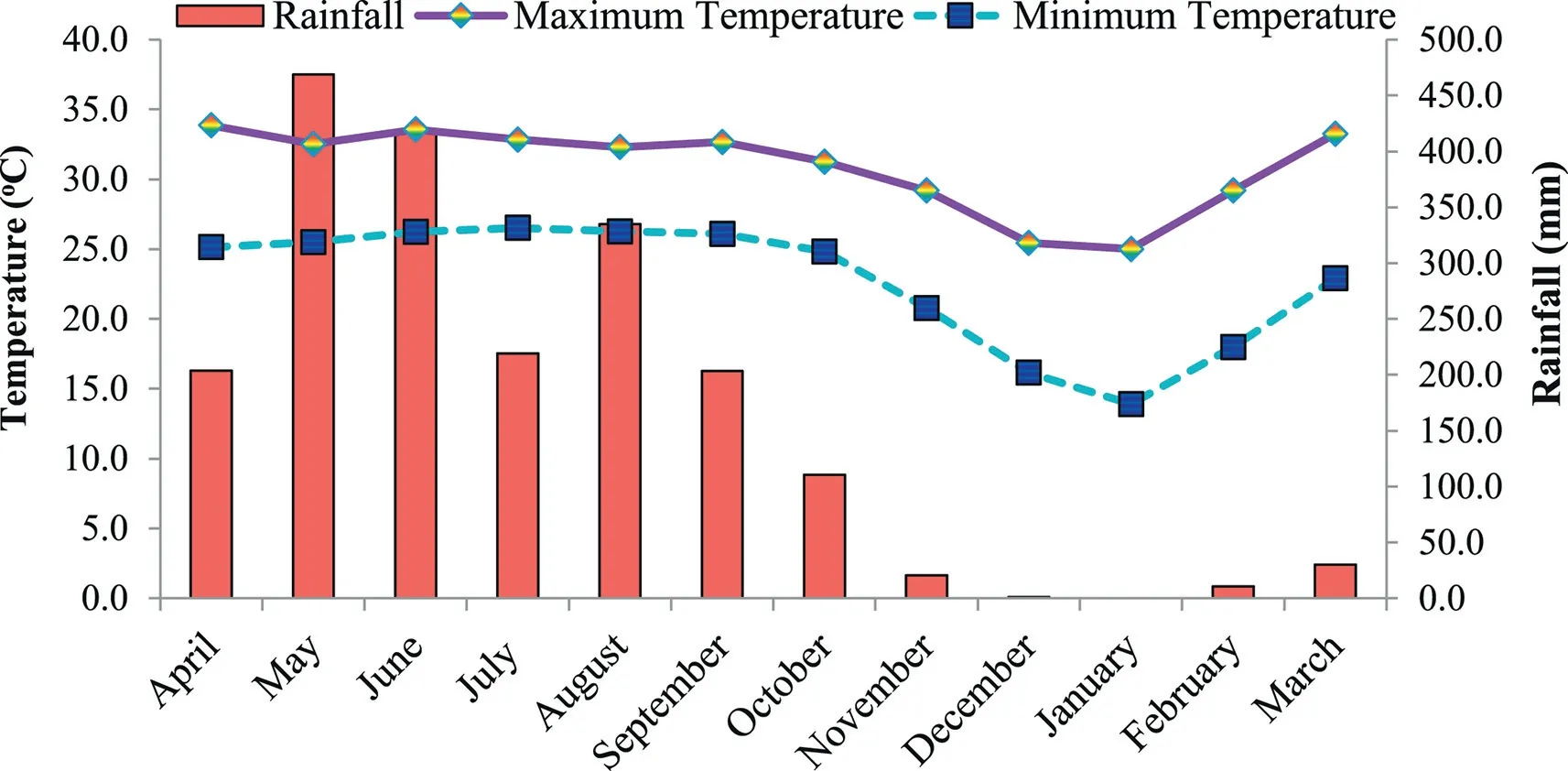
Fig.1.Weather condition of the experimental site during the study period(mean data of two years).
The experiment was laid out in a Randomized Block Design with three replications.The gross plot size was 5×4 m2.The experiment consisted of six combinations of tillage and establishment methods:1)CT-FB:conventional tillage(CT)with flat bed planting(FB)(Two cross ploughing with power tiller to a depth of 15 cm followed by leveling),2)CT-RF:CT with ridge and furrow planting(RF),3)CT-RB:CT with raised bed planting(RB),4)NT-FB:no-till(NT)with FB,5)NT-RF:NT with RF,and 6)NT-RB:NT with RB.The field layout for tillage and management practices is shown in Fig.2.Fixed plot was maintained for treatments during two years of the study to evaluate cumulative effects of treatments on soil properties.Glyphosate[N-(phosphonomethyl)glycine]was applied at 5 ml l-1to control weeds in all NT plots about a week prior to sowing.These six treatment combination effects were assessed on fixed plots in maize(summer)-maize(rainy season)-field pea(winter)system.Maize in summer and rainy season were cultivated for green cob and grain(seed),respectively.Winter crop pea was grown for grains.A fertilizer dose of 120 kg N,27 kg P and 34 kg K ha-1were applied to each of summer and rainy season maize.Whereas,a fertilizer dose of 20 kg N,27 kg P and 34 kg K ha-1were applied to field pea.Half of the N and full dose of P and K was applied at sowing in maize(summer and rainy season),and the remaining half was applied through two splits;first half at knee high stage and the second half at the tasseling stage.However,full dose of N,P and K fertilizers were applied at the time of sowing for field peas.Urea(46% N),single super phosphate(16% P205)and muriate of potash(60% K20)were used as N,P and K sources,respectively.The popular maize hybrid DMH-849 was sown manually using a dibbler at 60×30 cm spacing during summer and rainy season under both CT and NT systems and field pea variety TRCP-9 was sown using a manual dibbler at 30×10 cm spacing after the harvest of rainy season maize on residual soil moisture.Summer and rainy season maize were sown during 6-8 April and 7-9 July and harvested in 26-28 June and 27-29 September,respectively.The winter crop pea was sown and harvested during 6-8 November and 22-24 February,respectively.Summer and rainy season maize were grown entirely under rainfed conditions.Whereas,two life-saving irrigation(3 cm each)was provided at pre-flowering and pod filling stages in winter season pea crop.Two hand weddings were performed at 20 and 45 days after sowing(DAS)under CT and one hand weeding at 30 DAS under NT in all three crops.The weed biomass under NT system was retained on the surface and removed in case of CT.The prevalent practice followed by the farmers is adoption of CT with removal of weeds and placing them on field bunds or throwing it in nearby uncultivated areas/fallow fields.The amount of crop residues produced under different treatments were retained under NT and incorporated under CT systems(Table 1).
2.3.Harvesting,economic yield and biomass measurement
Fresh green cobs of summer maize were harvested manually in the standing crop,about a week before physiological maturity.After harvest of green cobs,maize stalks were cut and stover weight determined after oven drying at 60°C for 48 h.Rainy season maize and field pea were harvested manually at about 10 and 2-cm above the ground level,respectively.Border one rows of crops(maize,pea)all-around the experimental plots were harvested first,and remaining net area was harvested for assessing grain and stover yields.Grain yield of the rainy season maize and winter field pea were reported at 12%moisture content.Maize and field pea stover biomass(on oven dry weight basis)was measured for every year of the experiment.A 3.0 Mg ha-1biomass of previous field pea crop(grown during previous winter season before initiation of the present study for soil homogenization)was considered as the initial biomass contribution to the first summer maize crop(2012).The estimated C input(ECI)was calculated by assuming the carbon concentration of 40%(Bolinder et al.,2007).
The mean annual input of organic biomass/residues to soil from all crops(Table 1)varied with aboveground yield responses of crops and the tillage treatment.Hence,there was a yearly variation in the total amount of residues added under different treatments.Cumulative residue input was 39.3 Mg ha-1in the CT-RB compared with 37.1 Mg ha-1for the CT-FB plots(Table 1).Thus,about 15.2-16.1 Mg C ha-1was added to the soil(0-30 cm)through residues incorporation/retention under different CT and NT systems(Table 1).Total residue addition in the NT plots was higher than that in CT plots,mainly due to a higher aboveground residue production and retention.The crop residue of the current season was used in the following season.For example,crop residue of summer maize was retained under NT and incorporated under CT in the following season i.e.,rainy season maize and likewise.
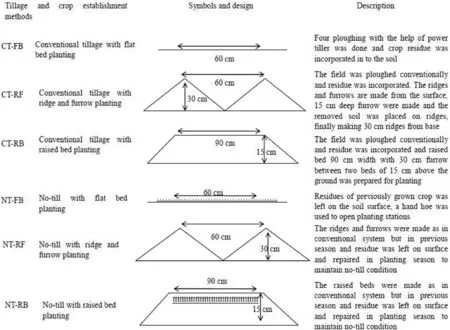
Fig.2.Treatments details with symbols and descriptions.

Table 1 Treatment-wise mean aboveground residue addition(Mg ha-1)over the years and cumulative aboveground residue and residue C input.
2.4.Equivalent maize grain yield(MEY)
Total crop productivity of each treatment of the system(summer maize-rainy season maize-field pea)(i.e.,system productivity)was compared by computing the maize equivalent yield(MEY)following the procedure described by De Wit(1960).The latter was assessed from the actual yield of the crops and their respective market price for the specific harvesting seasons(Eq(1)).

where all the yields are in Mg ha-1and market price in $ Mg-1.
2.5.Soil sampling and analysis
Base line ten composite soil samples were obtained prior to initiating the experiment from 0-15 and 15-30 cm soil depth for determining soil pH,bulk density(ρb),SOC and available N,P and K.Soil samples(three samples composited into one)for moisture content determination were collected using a soil auger from 0-15 cm depth from each plot after harvest of each crop and determined gravimetrically.Whereas,for assessing impact of treatments on soil physico-chemical properties,soil samples(three samples into one composite sample)were obtained after completing two cropping cycles at the time of harvest of field pea from each plot at 0-15 and 15-30 cm depths.Samples were drawn from centre of two rows leaving two border rows.Samples were air dried under laboratory conditions until constant weight,gently ground and passed through a 2-mm sieve for chemical analysis.Soil available nitrogen(N)was determined by alkaline potassium permanganate method(Subbiah&Asija,1956),P by Bray and Kurtz No.1 method(Olsen & Sommers,1982)and K by ammonium acetate method(Knudsen et al.,1982).The SOC concentration was determined by Walkley and Black method(Nelson&Sommers,2005)and soil pH by the glass electrode method(Kalra,1995).
Intact core samples(5 cm diameter and 5.3 cm length)were obtained in triplicate for 0-15 cm and15-30 cm soil depth from all plots at the end of the two cropping cycles(after pea harvest)using stainless steel cylinders.The samples were oven dried at 105oC for 24 h and the ρbwas calculated based on oven dry weight(Eq(2)).

where,Msis mass of oven dry soil(Mg),and Vtis total volume of soil core(m3).
2.6.SOC stock,sequestration and carbon retention efficiency
About 1 kg of bulk soil samples composed of three sub-samples were collected from each plot at 0-15 cm and15-30 cm depth at the end of the experiment.Half of the bulk sample was air-dried,crushed and sieved through a 2-mm diameter sieve and used for SOC determination.
Total SOC stock(Mg ha-1)for 0-15 cm and 15-30 cm depth was computed by using equations(3)and(4):

where,MESM is Minimum equivalent soil mass,minimum bulk density of treatment CT-RB was used to calculate MESM.

The SOC stocks of two layers were summed up to obtain the profile SOC stock.
Sequestration of SOC was computed by equation(5)(Srinivasarao et al.,2012):

Carbon retention efficiency(CRE)was calculated by Eq(6)(Bhattacharyya et al.,2009b):

The final and initial SOC stocks(Mg ha-1),and ECI is cumulative estimated C input(Mg ha-1)were computed to assess the rate of SOC sequestration.
2.7.Statistical analysis
Data obtained were subjected to analysis of variance(ANOVA),to test the significance of the overall differences among treatments by the“F’test.When the‘F’value was found to be significant,the least significant difference(LSD)at p=0.05 was computed to test the significance of the difference between the two treatment means(Gomez & Gomez,1984).
3.Results
3.1.Aboveground biomass yield and plant derived C inputs to soil
The aboveground biomass was significantly(p=0.05)affected by tillage and crop establishment methods.Summer maize under NT-RB and NT-RF produced significantly more biomass compared to that under CT-RB,CT-RF and CT-FB treatments(Table 2).The maximum summer maize biomass was produced under NT-RB(11.25 Mg ha-1)in 2012 and NT-RF(11.66 Mg ha-1)in 2013.Rainy season maize showed different trends,the CT-RB and CT-RF had higher aboveground biomass yield by 3.0-11.1% in 2012 and 7.0-18.9% in 2013 over the NT systems(NT-RB,NT-RF and NT-FB).The rainy season maize biomass under CT-RB was 5.3%,11.1% and 7.7% higher than those observed under NT-RF,NT-FB and NT-RB,respectively in 2012.However,in 2013,the rainy season maize grown under the CT-RF management produced 10.5%,18.9% and 12.5 higher aboveground biomass than that under NT-RF,NT-FB and NT-RB treatments,respectively.Field pea produced themaximum aboveground biomass yield under CT-RF.About 15.2-16.1 Mg C ha-1was added to the soil(0-30 cm)through residues incorporation/retention under different CT and NT systems(Table 1).Total residue and C addition under NT was higher than that under CT,mainly due to higher aboveground biomass production and addition.The highest amount of plant-derived C(16.1 Mg C ha-1)was added under CT-RB through addition of crop residues(Table 1).

Table 2 Effect of tillage and crop establishment methods on crop biomass production(Grain+stover).
3.2.Economic yield
The NT-RB produced significantly higher green cob yield than those under CT-RF and CT-FB treatments.The summer maize green cob yield did not differ significantly among NT-RB,NT-RF and NT-FB treatments in 2012(Fig.3).However,the trend differed in 2013;NTRF produced the maximum summer maize green cob yield.The adoption of RF planting system under CT had an adverse impact on green cob yield.Thus,the CT-RF produced the lowest green cob yield.In 2012,summer maize grown under NT-RB management yielded 12.3% more green cob yield than that under CT.In 2013,however,NT-RB produced 14.5% more green cob yield than that under CT.
Rainy season maize grain yield was markedly influenced by tillage and crop establishment methods,and was significantly higher under CT-RB compared to that under other treatments(Fig.4).In 2012,CT-RB produced 2.2-10.4%higher maize grain yield over other treatments.However,in 2013,CT-RF and CT-RB treatments produced higher grain yields compared to those in other treatments,and recorded 10.2-18.3% and 7.1-14.7% more yields,respectively than that under NT-FB due to better above and below ground growth parameters.Field pea seed yield was the highest under NT-RB(1.11-1.13 Mg ha-1),and it was comparable to that obtained under CT-RB(1.04-1.06 Mg ha-1)and NT-FB(1.02-1.05 Mg ha-1),but higher than those under CT-FB,CT-RF and NT-RF treatments(Fig.5).
3.3.System productivity in term of maize equivalent yield
There was a significant effect of tillage and crop establishment techniques on system productivity in term of maize equivalent yield(MEY).The NT-RB produced the highest MEY,which did not differ significantly than those of the productivity under NT-FB,NTRF and CT-RB but was significantly greater than those under CT-FB and CT-RF management(Table 3).
3.4.Soil physicochemical properties
3.4.1.Soil moisture content
Soil moisture content after harvest of each crop was significantly influenced by tillage and crop establishment methods.Soil moisture content decreased slightly from harvest of summer season maize to the harvest of the winter field pea crop(Table 4)and followed the same trend as that of the monsoon rainfall.The NT-RB treatment had higher soil moisture content,which was similar to those in NT-RF and NT-FB but significantly higher than those under CT-FB and CT-RF treatments(Table 5).The amount of soil moisture reserve after harvest of rainy season maize crop is more important than that after the harvest of summer maize for the succeeding field pea crop.The amount of soil moisture storage after harvest of rainy season maize was 26.3 and 31.6% under NT-RB,followed by that under NT-FB(21.1and 26.3%)and NT-RF(18.4 and 21.1%)but higher than that under CT-RF during 2012 and 2013,respectively.
3.4.2.Bulk density
Tillage and crop establishment methods had significant effect on ρbat 0-15 and 15-30 cm soil depths(Table 5).The ρbincreased with increase in soil depth for all tillage and crop establishment methods.The lowest ρbwas observed under CT-RB and it was similar to that under CT-RF.However,greater ρbwas observed under NT-RB and NT-FB treatments than those under CT systems.
3.4.3.Soil pH
There was no significant effect of tillage and crop establishment methods on soil pH after completion of two cropping cycles(Table 5).The average value of soil pH across all treatments was 5.60 to 0-30 cm depth.Soil pH was more in 0-15 cm(5.72)than in 15-30 cm(4.72)depth.
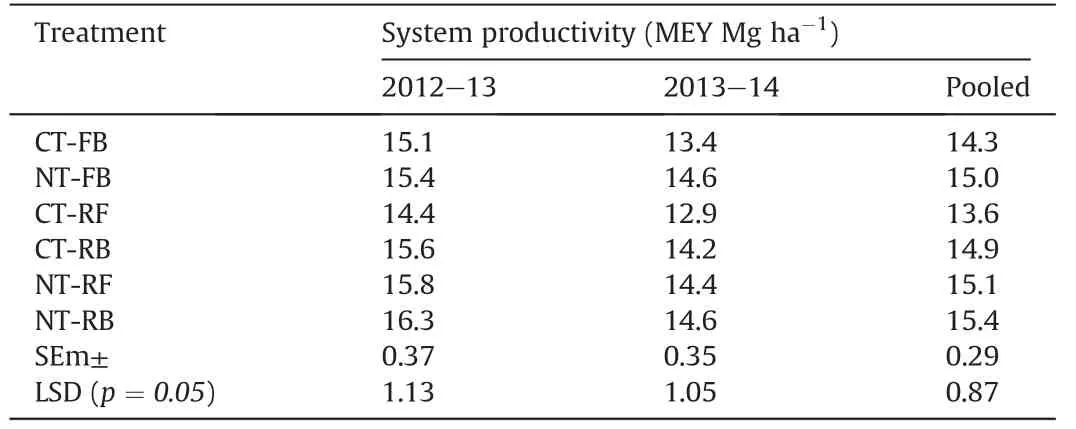
Table 3 Effect of tillage and crop establishment methods on system productivity.
3.4.4.Available NPK
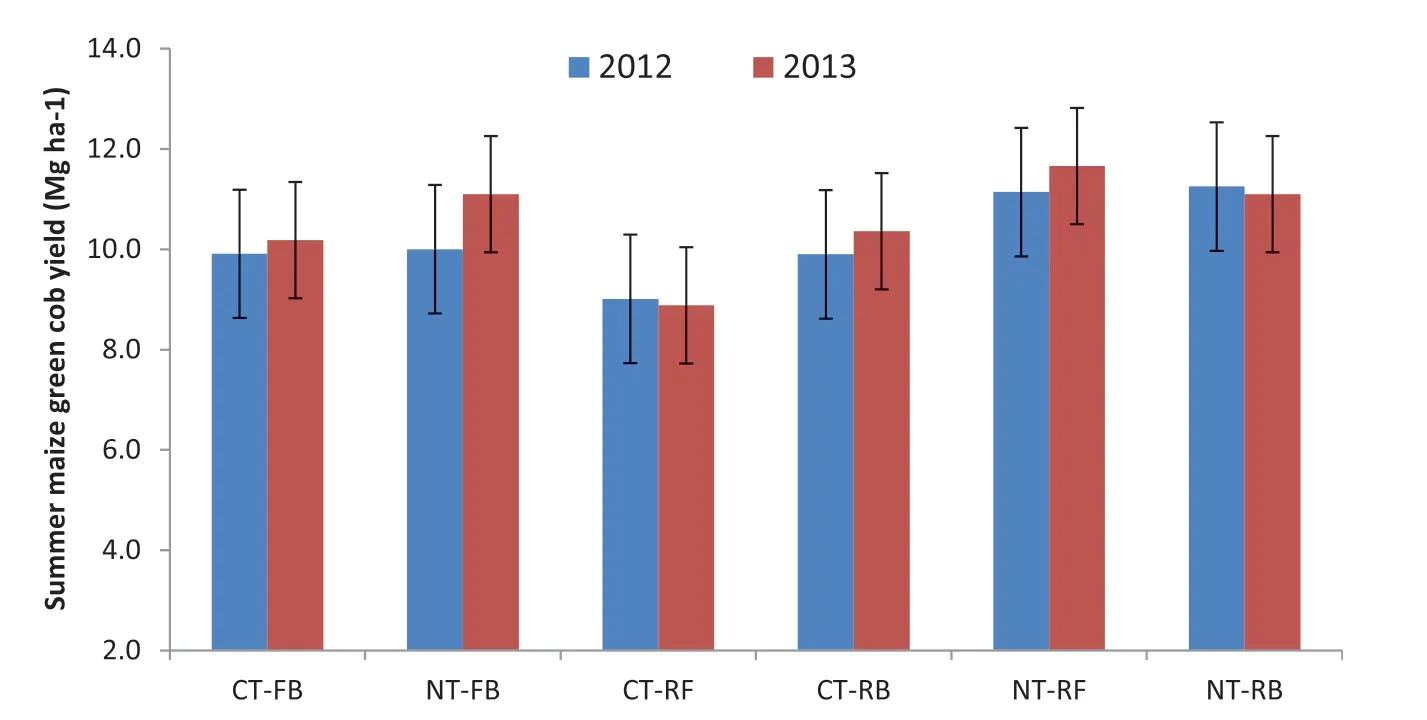
Fig.3.Effect of tillage and crop establishment methods on summer maize green cob yield(vertical bars in both the way represents LSD at 5% probability).
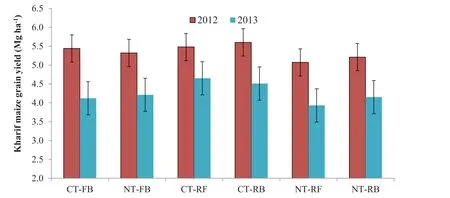
Fig.4.Effect of tillage and crop establishment methods on rainy season maize grain yield(vertical bars in both the way represents LSD at 5% probability).
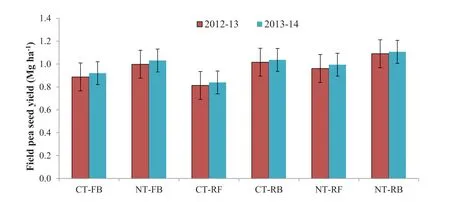
Fig.5.Effect of tillage and crop establishment methods on field pea seed yield(vertical bars in both the way represents LSD at 5% probability).
The available N,P and K after the two cropping cycles were significantly influenced by tillage and crop establishment methods.Most of these nutrients were concentrated in 0-15 cm layer as compared to 15-30 cm layer.The amounts of available NPK(330.2-338.0 kg N ha-1,8.9-9.2 kg P ha-1and 328.0-330.9 kg K ha-1)under NT systems were higher in 0-15 cm compared to those in the 15-30 cm soil depth(Table 6).In 0-15 cm depth,NT-FB,NTRF and NT-RB recorded significantly higher available N,P and K compared to those under CT-FB,CT-RF and CT-RB treatments.In 15-30 cm depth,available N and P followed similar trends but available K was higher under CT compared to that under NT systems.
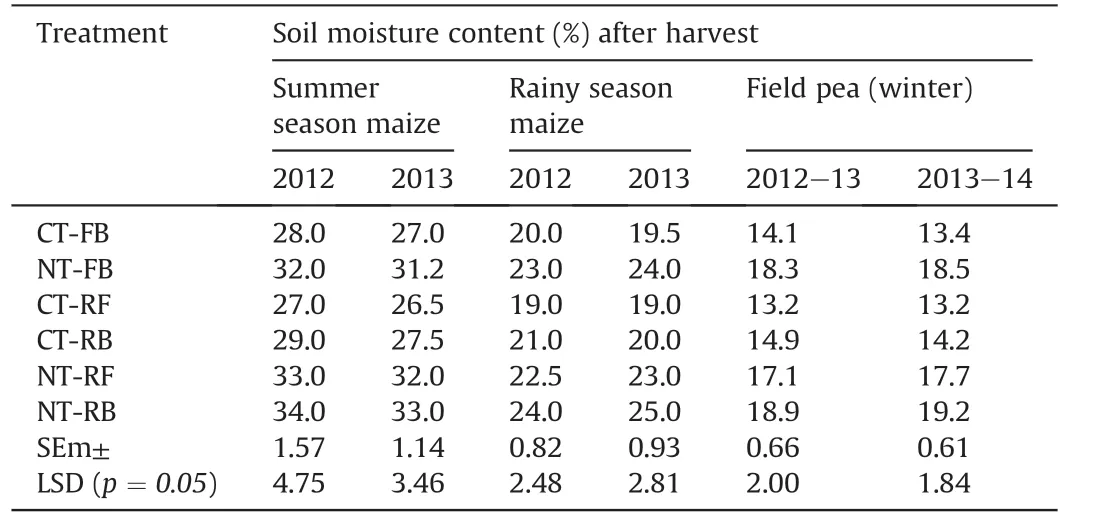
Table 4 Effect of tillage and crop establishment methods on soil moisture content after harvest of crops(0-15 cm).
3.5.Soil organic carbon concentration,stocks,sequestration and retention efficiency
The SOC concentration differed significantly among soil depths(Table 5).In 0-15 cm depth,SOC concentration was higher under NT-FB and NT-RB than those under other treatments.The NTsystems restored SOC in 0-15 cm layer,while it was distributed in ploughed layer in soil under CT management.Treatments did not affect SOC concentration in 15-30 cm depth.There was a trend of higher SOC concentration in 15-30 cm depth under NT than that under other treatments.

Table 5 Effect of tillage and crop establishment methods on soil physico-chemical properties.

Table 6 Effect of tillage and crop establishment methods on available N,P and K in soil after completion of two cropping cycles(at the end of study).

Table 7 Effect of tillage and crop establishment methods on carbon stock and sequestration rate.
The SOC stocks,cumulative C stocks,C sequestration rate and cumulative C sequestration were also significantly influenced by tillage and crop establishment methods,and followed the trend similar to that of SOC concentration(Table 7).The highest SOC stocks,cumulative SOC stocks,C sequestration rate and cumulative C sequestration were observed under NT-RB and NT-FB compared to other treatments(Table 7).The NT systems had the highest SOC gain(0.85 Mg C ha-1y-1)in the 0-30 cm soil depth over the baseline.There were significant improvements in SOC stocks in the NT-FB and NT-RB plots.The CRE under NT-FB,NT-RB and NT-RF plots was 10.6,10.6 and 8.3%,respectively and was significantly higher than those under CT-FB,CT-RB and CT-RF(Fig.6).Regression analysis indicated that the linear relation of CRE and C sequestration rate to added cumulative C inputs were not significant at p=0.05(Fig.7).
4.Discussion
4.1.Aboveground biomass yield and plant derived C inputs to soil
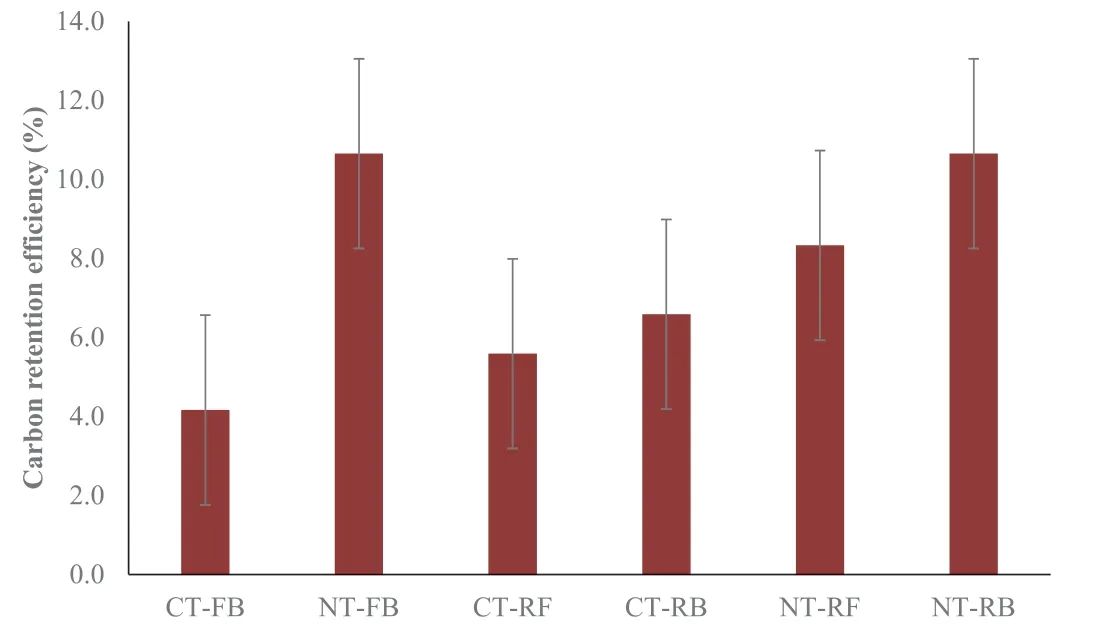
Fig.6.Effect of tillage and crop establishment methods on carbon retention efficiency(vertical bars in both the way represents LSD at 5% probability).
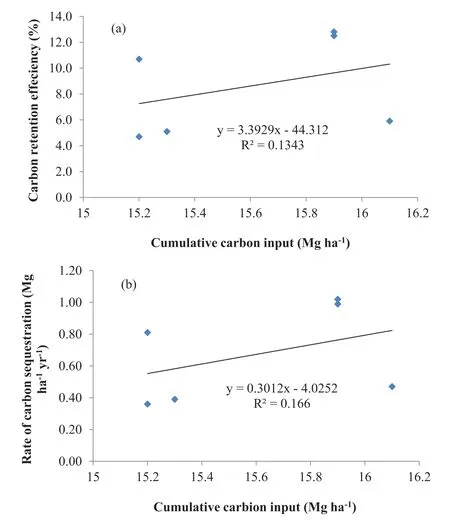
Fig.7.Linear relationship of carbon retention efficiency(a)and carbon sequestration rate(b)to cumulative carbon inputs.
In general RB planting had higher net primary productivity(aboveground biomass yield)compared to that under conventional or FB planting.Maize and field pea responded positively to RB and RF planting.Such trends might be due to multiple factors,including lower weed density,reduced competition for resources,improved soil water regimes and better aeration and nutrient use since nutrients are applied near the root zone(Das et al.,2013;Saha &Ghosh,2010).Treatments involving NT systems had higher aboveground biomass yield of summer maize compared to those under CT systems irrespective of the establishment methods.A slight reduction in rainy season maize and field pea biomass yield might have occurred due to poor crop stand under NT compared to that under the CT planting systems.The stalk rot infestation of maize plants was observed under NT during rainy season than that under CT,which may be attributed to low plant stand at harvest and consequently low biomass yield under NT.In general,NT and residue retention reduce early growth and increases stalk rot infestation during wet season as reported by a study in Mexico(Monneveux,Quillérou,et al.,2006).Furthermore,high rainfall and its uniform distribution during rainy season favour the maize growth more under CT than that under NT.Monneveux,Quillérou,et al.(2006)also reported that NT is associated with less biomass and grain yield.
4.2.Economic yield
The economic yield of crops had a variable response to different tillage and establishment methods,because both positive and negative effects of tillage were observed in the present study.However,the overall impact of NT systems on cropping system was positive.NT systems(NT-RB,NT-RF and NT-FB)produced higher summer maize green cob and field pea yields than that by the CT systems.Among the three establishment methods,there were no significant differences in economic yield during 2012.However,in 2013,RF establishment method produced the highest summer maize yields.This trend may be attributed to efficient use of limited summer rain water under RF compared with that under other methods.These trends may be ascribed to the improvement in soil profile moisture storage,favorable physico-chemical properties and the available nutrient status of the soil through retention of residues under NT systems(Awasthi et al.,2007;Olson et al.,2004).However,the data presented here in show negative effect of NT on the rainy season maize grain yield.The yield reduction under NT systems(rainy season maize)in the present experiment was mainly due to a reduction in the number of grains per cob and plants per plot.As the maize plants under NT system was infested by the stalk rot,which led to a low plant stand at harvest and lower yield than that under the CT system.
4.3.System productivity in term of maize equivalent yield
The system productivity was higher under NT(NT-RB,NT-RF and NT-FB)as compared to that under CT systems(CT-RB,CT-RF and CTFB).The system productivity was higher under RB followed by that under RF than FB,which was mainly due to efficient use of limited water during the dry season(summer and winter)and drainage of excess water during the rainy season leading to higher productivity of crops in the respective season(Saha et al.,2010).Increase in system productivity was due to higher yield of summer maize and dry season field pea under NT than that under CT systems.Increase in yield of summer maize and dry season field pea was attributed to higher soil moisture content and availability of nutrients(Monneveux,Quillérou,et al.,2006).
4.4.Soil physical and chemical properties
Reduction in the tillage and retention of crop residue are important strategies for some sloping lands towards soil and water conservation and sustainability of agricultural systems(Iqbal et al.,2011).In the present study,soil moisture content after harvest of each crop was significantly higher under NT than that under CT systems.The soil moisture content was higher after harvest of summer maize,and the lowest after harvest of field pea.This trend was due to more amount of rainfall received during the summer maize season and no rainfall during field pea season.The highest soil moisture content was observed under NT-RB followed by that under NT-RF and NT-FB treatments.However,soil moisture content under all the CT treatments was lower than those under NT systems.The soil moisture content after harvest of the rainy season maize crop was considered more important than that after the harvest of summer maize and field pea,and it played a significant role in timely sowing and better germination of field pea.The higher soil moisture content in NT systems might be due to more infiltration of excess rainwater by retention of crop residues on soil surface,and high water holding capacity of soil because of a higher SOM content(Das et al.,2017).These results indicated that NT systems conserve more soil moisture in the profile than CT systems;because of residue mulch,less evaporation and increase in water holding capacity(Das et al.,2019).The soil moisture content under summer maize and winter field pea was greater than that under RB than RF and FB systems.This trend was mainly due to efficient conservation of limited water in the soil profile compared with other systems.The greater ρbunder NT systems may have also increased water storage capacity in coarser soil of a sandy loam texture,which in association with reduced water evaporation from the soil surface due to residue retention enhanced available water storage(De Vita et al.,2007).Alterations of land micro relief might have also influenced the infiltration of rain water.Soil ρbincreased with increase in soil depth irrespective of tillage and crop establishment methods.All the CT systems(CT-RB,CT-RF and CT-FB)had significantly lower ρbin the 0-15 cm and 15-30 cm layers due to loosening of the soils by tillage and the mixing of crop residues into the plow layer(Das et al.,2013;Hussain et al.,1998).Despite the retention of residues on soil surface and higher SOC content,NT systems(NT-RB,NT-RF and NT-FB)had higher soil ρbin the 0-15 cm than that in the 15-30 cm layer(Das et al.,2013;Lampurlanes&Cantero-Martinez,2003).Soil pH in 0-15 cm depth was relatively higher under CT-RB compared to all other treatments,but NT-FB had the highest soil pH in 15-30 cm layer.Low soil pH under NT might be due to differences in method of fertilizer application.The N fertilizer applied under NT might have been retained in the surface layer,which could not leach beyond 15 cm depth.In contrast,the N fertilizer was incorporated in soil under CT,which might be the reason for lower pH of soil under NT than that under CT.
Comparing two tillage systems,more available N,P and K concentrations were observed under NT than CT system at 0-15 cm depth(Lopez-Fando&Pardo,2009;Mina et al.,2008).In 15-30 cm depth,N and P had the similar trends but available K was higher under CT compared to NT systems.Greater available soil nutrients in the surface layers under NT than that under CT have also been reported by others(Thomas et al.,2007;Unger et al.,1991).This trend is apparently due to reduced mixing of fertilizer P and subsequent increase in organic P compounds which is more mobile in soil than is inorganic P(Schomberg et al.,1994).Results presented herein also indicated greater available N,P and K under NT-RB compared to other treatments for 0-15 cm layer which can be attributed to higher SOM content than that in other systems.Higher concentration of P in the 0-15 cm layer under NT might be attributed to high SOM content and surface application of P fertilizers(Van et al.,2017).The SOM is an important factor affecting the adsorption-desorption of soil P through different mechanisms(Yang et al.,2019).The retention of crop residue under NT increases SOM which could efficiently enhance P availability by reducing the strength of P adsorption and the maximum phosphate buffering capacity and increasing the desorption of P to some extent(Yang et al.,2019).Increase in K content in the 0-15 cm layer under NT than CT soil is consistent with the report of Martin-Rueda et al.(2007).
4.5.Soil organic carbon concentration,stocks,sequestration and retention efficiency
Reducing tillage intensity and retention of crop residue are important strategies for soil and water conservation and sustainability of agricultural systems(Liu et al.,2015).Soil can be a source or sink for C depending on management strategies,and it also plays a vital role in the global C cycle(Blakemore,2018).These interacting practices can alter nutrient movement and availability to the crops,reduce water loss,decrease rate of OM decomposition,and thus,enhance C sequestration(Iqbal et al.,2011).In the present study,concentration of SOC decreased with the increase in soil depth.Similar trends were reported by Choudhary et al.(2013).However,at 0-15 cm soil depth,SOC concentration was higher under NT-RB and NT-FB systems than that in other treatments probably due to surface application of residue mulch and protection of the soil surface from raindrop impact and erosion(Bhattacharyya et al.,2013;Chivenge et al.,2007)which enhance soil C sequestration(Lal & Kimble,1997).However,the lowest SOC concentration was observed under CT-FB and CT-RF treatments probably because of higher losses by SOM decomposition(Bono et al.,2007;Rice,2002).Soil disturbance by tillage reduces stability of SOM and aggravates its depletion(Ghuman&Sur,2001;Six et al.,2000).Similar results of higher SOC concentration in soils under NT than CT have also been previously reported from eastern Himalayas(Das et al.,2018;Ghosh et al.,2010)and other parts of the world(Bessam&Mrabet,2003;Freixo et al.,2002).
The benefits of sequestering SOC to sustain crop productivity by adopting CA have been widely reported in the temperate and subtemperate regions(Bhattacharyya,Tuti,Kundu,et al.,2012;Bono et al.,2007).During last two decades,a large number of studies have also been conducted on CA and its effect on soil health,Csequestration,and to sustain crop productivity in tropical Asia including India(Bhan&Behera,2014;Meena et al.,2015)and South America(de Freitas&Landers,2014;Sokolowski et al.,2020).Even in semi-arid tropics in India a number of literatures are available on impact of CA on carbon sequestration.However,there are only a few studies conducted for the North Eastern Himalayan region,which is one of the most fragile region of the world.Globally,rates of C sequestration by different types of management range from 0.11 to 3.04 Mg C ha-1y-1,and are influenced by the type of cropping,management practices and climate(Conant et al.,2001).In our study,total C sequestration rates under NT(0-30 cm soil depth)ranged from 0.65 to 0.85 Mg ha-1y-1as compared to that under CT plots where sequestration rates range from 0.32 to 0.53 Mg ha-1y-1.Thus,conversion of CT to NT systems have potential to increase SOC stock in the studied agro-ecosystem of eastern Indian Himalayas.NT-FB system had the highest C stocks,cumulative C stocks,C-sequestration and cumulative C-sequestration followed by NT-RB.NT had higher CRE as compared to CT systems.CRE under the NT-FB,NT-RB and NT-RF were 10.7%,10.7%and 8.3%,respectively and were much higher than those observed under CT-RF plots.Higher SOC stocks under NT than CT systems have also been previously reported by others(Choudhary et al.,2013;Das et al.,2017).The present study indicated the beneficial effects of NT on improving C-reserves than CT systems and supported the hypothesis that NT systems with adequate C input have a large potential to reverse the process of soil degradation and improve soil and crop productivity.Furthermore,the no significant regression relation(linear,p=0.05)between CRE and the cumulative C inputs,and C sequestration rate and the added cumulative C inputs,indicated that tillage and land forming had more control over CRE and C sequestration rate in this agro-ecosystem.
5.Conclusions
The data presented proved the hypothesis,and support the following conclusions-
1).System productivity of maize-maize-field pea system was higher under NT systems due to improvement in soil properties than that under the CT system.
2).Field pea seed yield after rainy season maize was the highest under NT-RB due to efficient use of limited water during the dry season and improvement in soil properties.The same tillage and land shaping combination also had the highest cumulative C-sequestration rate.
3)NT systems had higher available N,P,K and 18.6-31.4%higher soil moisture content at rainy season maize harvest than that of CT systems
4)SOC concentration,stock and sequestration were more under NT systems due to higher C input than under CT system.
Therefore,adoption of NT-RB based planting systems has the potential to enhance the productivity,improve soil physicochemical properties,and increase C stock and retention efficiency and make production system sustainable in high rainfall areas of studied agro-ecosystem in Eastern Indian Himalayas and similar other agro-ecological regions to achieve Sustainable Development Goal by 2030.The present study on maize(summer)-maize(rainy)-field pea(winter)system was conducted for two consecutive years.Thus,a total of 6 crops were raised in 2 year.Though the period is not enough for a consistent results,it provided a very good opportunity to understand the impact of tillage and establishment practices on soil properties and productivity of the maize based system in fragile Himalayan ecosystem.For a consistent and stabilized results,a longer duration study is warranted.
Note
Confirmed that there is no conflict of interests by the authors.
Acknowledgements
The authors are thankful to the Director,ICAR Research Complex for NEH Region,Umiam,India and NICRA(National Innovation on Climate Resilient Agriculture)for providing necessary facilities and financial support to conduct the study.
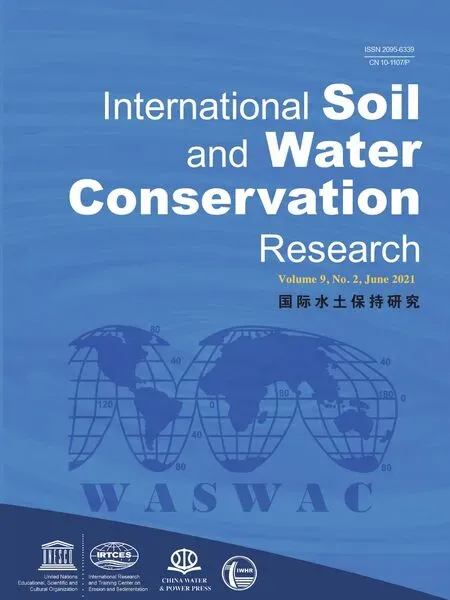 International Soil and Water Conservation Research2021年2期
International Soil and Water Conservation Research2021年2期
- International Soil and Water Conservation Research的其它文章
- Predictions of soil and nutrient losses using a modified SWAT model in a large hilly-gully watershed of the Chinese Loess Plateau
- Carbon sequestration benefits of the grain for Green Program in the hilly red soil region of southern China
- Crop productivity,soil health,and energy dynamics of Indian Himalayan intensified organic maize-based systems
- Near-saturated soil hydraulic conductivity and pore characteristics as influenced by conventional and conservation tillage practices in North-West Himalayan region,India
- Determinants of adoption of multiple sustainable agricultural practices among smallholder farmers in Nigeria
- Wear of the working parts of agricultural tools in the context of the mass of chemical elements introduced into soil during its cultivation
